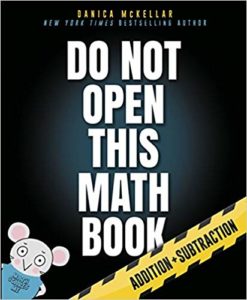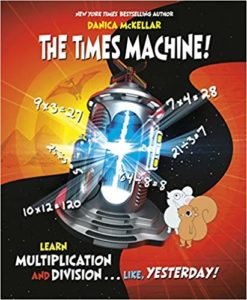Danica McKellar is an actress on the Hallmark Channel, with a movie due out this Spring. However, most people who watch her are not aware that she has more serious interests as well. As a former math major, Danica has used both her education and her story-telling skills to reach out to students of math – young and old. This interview reveals another side of this talented woman.
Thank you for agreeing to this interview. So primarily, why do you tackle the subject of math in your books?
I LOVE math! I am only interested in making things that don’t already exist and that are helpful. I have this drive to help (students). I loved being a math major. I love the challenges it brings. I love home-schooling my son and teaching him math, and just everything about math is fun.
I want to bring that joy to other people, and I hate the idea that there are so many kids (and parents) who are just so frustrated and find mathematics scary. So, I set out to change that mindset and make it entertaining, but educational as well. By writing books, I can reach a lot more kids all over the world.
The process of creating any book can be a long and tedious venture. Provide for us a bit of insight on some of the steps that you take to ensure that your books are published just the way that you envisioned.
I come up with the basic concept (addition/subtraction, multiplication/division, etc.) and what I envision, and then I present it to the publishing company. I follow this up by talking to teachers because I am not in the classroom. I want to know what’s going on. What concepts are children struggling with, and what resources are needed? I am here to expand on what the teachers are doing.
Additionally, I order math textbooks, read them, and try to become the best expert that I can within the concept that I am exploring. I love this part of the process! From here, the first draft begins for me. On average, this takes a little over a year. After ten books, I quickly learned that the first few weeks of writing often don’t end up in the book at all! But by the time I’m done with the first draft, the text is very close to how it will end up in the final version. It’s an evolution that takes patience.

In most of your books, you use the comic book approach for your illustrations, which is especially evident in Do Not Open This Math Book and The Times Machine. How much input do you have with the illustrations?
I provide my very detailed, comic-book drawing ideas for the illustrator and submit it to the editor who then passes those on. Later, I get a rough draft of the designs and make modifications accordingly. It goes back and forth for a while until it’s just right!
You enjoy writing about math, all while giving new life to children who have always struggled with the subject. Many of your testimonials that you publish in your books are proof of this. What is your favorite part of creating a book?
I love to use this outlet, especially to encourage young girls. Any subtle way that I can fit into my books, I do (i.e., using the Danica cartoon character and other women figures). My hope is for girls to gain confidence and to show the importance of math, no matter what they decide to do when they grow up, whether it be a teacher or an actress or a mathematician for NASA. I provide analogies, stories, and things that might seem frivolous or silly, but in the end, math applies to it all. Most importantly, it teaches them to be problem solvers. In the end, I just want to make it fun, understandable, and accessible, with lots of comedy within the text. I am an entertainer at heart, and writing entertaining math books seemed like something that didn’t exist.

Tell us a little about your latest book, The Times Machine, due out in June 2020.
I’ve been looking forward to this book for a long time – and this one is over four years in the making! My inspiration for writing this book has always been to help children memorize their multiplication tables. Time is fleeting in the classrooms and I thought it was time to introduce a new way of learning these besides the rote memorization that teachers and parents often rely on. Additionally, because children are learning new ways to do basic math concepts (i.e., long division) under the new Common Core requirements, I made it my task to make it fun and understandable! I tackle these new ways using charts, pictures, and cartoon characters for easy comprehension (for parents too!)
Your favorite children’s book?
When I was growing up, it was Ramona Quimby, Age 8 and The Mouse and the Motorcycle by Beverly Cleary. Now when I read with my son, we both cannot get enough of Who Moved My Cheese for Kids! The Magic Treehouse series will also always be a favorite as well.
Who inspired you to become the author you have today?
My 7th-grade pre-algebra teacher, Mrs. Jacobson. She taught me a whole new approach when it came to math tests.
What is next for you?
I have two more children’s books in the works over the next couple of years. In the short term, when The Times Machine comes out in the summer (2020), I will do a mini-book tour in NYC and LA, followed by the National Book Festival in DC in Fall 2020.
—
About McKellar Math
The mission of McKellar Math is to explain math concepts in fun, easy-to-digest ways with colorful analogies and simple tricks, and to show kids that math is an inherent part of the world around them. McKellar Math gives kids the tools they need to succeed in math and to build the confidence that comes from feeling smart.
https://donotopenthismathbook.com/ | Twitter | Instagram | Facebook
About the Author
A recent UCLA graduate with a degree in Mathematics, McKellar pledged to Congress that she would be a part of the solution. Kids in the US tend to view math as boring, scary, and just for nerds. Identifying the problem as mostly cultural, McKellar challenged these stereotypes with her first series aimed at middle school kids: Math Doesn’t Suck, Kiss My Math, Hot X: Algebra Exposed, and Girls Get Curves: Geometry Takes Shape.
This New York Times bestselling series of math books has helped thousands of students to improve their math scores, and their outlook on mathematics.
March 2017 saw the release of Goodnight Numbers, the youngest of the McKellar Math books, aimed at toddlers. Bathtime Mathtime, Bathtime Mathtime: Shapes, and Ten Magic Butterflies quickly followed. McKellar Math aims to ensure that kids experience math as a delight, a fun challenge, and an opportunity to get stronger and smarter – in all areas of life. Most recently, Danica authored, Do Not Open This Math Book to help youngsters with addition and subtraction. In June 2020, The Times Machine, a book to help 3rd-5th graders with their multiplication and division, will be released as well.
In addition to her lifelong acting career, Danica McKellar is an internationally-recognized mathematician and advocate for math education. A summa cum laude graduate of UCLA with a degree in Mathematics, Danica has been honored in Britain’s esteemed Journal of Physics and the New York Times for her work in mathematics, most notably for her role as co-author of a groundbreaking mathematical physics theorem which bears her name (The Chaves-McKellar-Winn Theorem).
For more on McKellar Math and to pre-order The Times Machine with a chance to receive an autograph, visit https://mckellarmath.com/, Twitter, Instagram, and Facebook.

